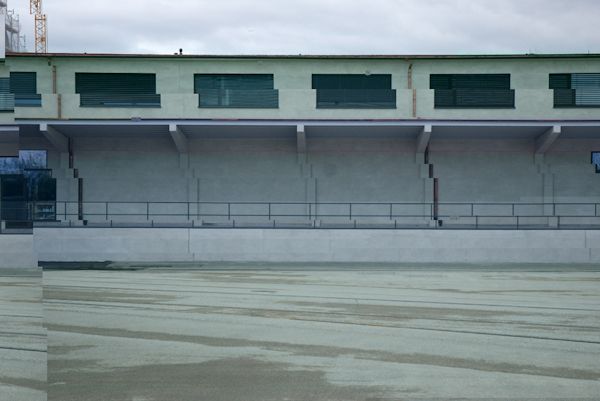[Even though they’re created with technologies, we’re used to perceiving buildings as ‘real’ physical objects; the example of glitch architecture in this story from The Creators Project (which includes a 0:43 minute video) makes observers question that perception, creating a type of inverse presence illusion that blurs real and virtual. For an interview with the architects see Hopes and Fears; for more on the “radical capacity of glitch art” see Redefine Magazine; and for the related short film “Algorithmic Architecture,” see more coverage by The Creators Project. –Matthew]
Glitch Architecture Shows How Beautiful Broken Can Be
By DJ Pangburn — Sep 27 2015
Few works in the last few years, apart from perhaps Trevor Paglen and Jacob Appelbaum’s Autonomy Cube, so perfectly blend the physical world with the deep web as !Mediengruppe Bitnik’s Random Darknet Shopper.
At the heart of this work is a random element: an algorithm buying things off the deep web (including ecstasy) and having them delivered to an exhibition space. The flair for all things arbitrary also popped up in !Mediengruppe Bitnik’s package addressed to Wikileaks’ Julian Assange, which contained a hidden camera that documented its own unpredictable journey to the Ecuadorian Embassy.
For its latest project, H3333333K, !Mediengruppe Bitnik—the artistic duo of Carmen Weisskopf and Domagoj Smoljo—introduced a new random element: glitch. The two applied a digital image error directly onto the façade of the House of Electronic Arts Basel (HeK), misaligning the façade’s element and, as they put it, “bringing disturbance to an otherwise settled structure.”
!Mediengruppe Bitnik wanted to discover what happens when a digital glitch migrates to a structure. More specifically, they wanted to know what happened when they took something ephemeral like a software error and applied it to a long-term physical architecture.
“The appropriation of a technical error, a glitch can be read as critical, by attracting attention to the material basis underlying digital technologies,” !Mediengruppe Bitnik’s Carmen Weisskopf tells The Creators Project. “The technical error interrupts the smooth functioning of media and raises questions which extend beneath the surfaces.”
“And this was exactly what interested us in our research for this public art piece,” she adds. “We wanted to intervene in a way which would characterize the building as a place for art by reflecting on the digital and its relationship to the physical.”
Weisskopf says that H3333333K grew out of interest in 3D models and renderings of the HeK building. She and Smoljo were intrigued by the current state-of-the-art architectural renderings that inadvertently fool the viewer into questioning whether the image is an actual photograph or a digital simulation. The real-versus-virtual tip-off, according to Weisskopf, is whether the people look “real.”
!Mediengruppe Bitnik wanted to reproduce that “moment” in H3333333K. It was also clear that they wanted to work with HeK’s architecture itself, and comment on the software behind the architecture—the way it shapes cities and buildings.
So Weisskopf and Smoljo began altering the building’s architecture with digital errors. The idea was, as Weisskopf says, to “cast something fluid, non-permanent like a software error into something physical and permanent, into architecture. A software error build [sic] out of stone.”
This manipulation of the image’s data source was a trial-and-error process, one that the pair repeated until they achieved an image error that was aesthetically interesting and feasible given the building’s structural and architectural dimensions.
The main difficulty was that they needed to ensure the glitch would not interfere with the building’s functionality. So, they had to think about where they would put the waterspout after they’d removed and cut the original into several pieces, rendering it nonfunctional. To do this, !Mediengruppe Bitnik worked closely with Zurich-based architect Reto Gsell.
“We couldn’t have realised the work without Reto,” Weisskopf says. “He translated the building and architectural processes for us. He immediately understood the conceptual idea, and thought it was interesting also from an architectural viewpoint. And he also related to the humor of the piece.”
“Looking at the facade from a distance, the glitch has a surreal quality,” Weisskopf says. “It produces a hyperreality, an irritation where you are not sure if it is really there or not.”
Weisskopf says that hacking familiar systems—in this case, a building—and intentionally creating glitches challenges the notion that technology must be seamless, faultless, and disturbance-free. Once the structure is undermined, she says, people can begin to question boundaries and develop new and unique voices or modes of expression.
For !Mediengruppe Bitnik, applying the glitch to HeK was also about better understanding the tools and structures surrounding them. “As soon as you understand a tool enough to use it in a way not originally intended, you also understand the politics that are incorporated into its design,” Weisskopf says. In developing H3333333K, they had hoped HeK’s visitors would do just that when viewing the glitched façade.
“The ability of the error to encourage viewers to think about and understand the structures that surround them became apparent at the opening,” Weisskopf adds. “People looked at the building wondering how it structurally works, wondering how rainwater is drained from the roof, and so on.”
“We do not have to accept the surfaces and devices we are given,” Weisskopf muses. “Glitches also react on the demand that everything should function according to a plan. They show just how beautiful broken can be.”
To learn more about !Mediengruppe click here.
